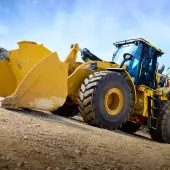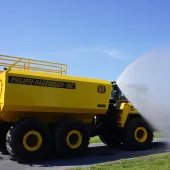Caterpillar unveil new 745 articulated truck

Latest model offers new cab design, advanced control features and increased comfort and productivity gains
THE new 41-tonne payload capacity Cat 745 articulated truck features Caterpillar’s next-generation cab design, which has been completely re-engineered to increase comfort and ease of operation, following global operator feedback.
The new external ‘spinal’ ROPS structure, for example, now boasts bonded rear quarter glass that eliminates the structural pillar to give the operator greater visibility from the cab. Upon cab entry, a new ‘wake up’ feature initiates machine displays as soon as the door is opened, while the lighter/stronger cab door offers shut assist for improved sealing against dust infiltration. In addition, the quieter cab design reduces noise by 5dB.
The cab also features new infrared glass that reduces solar heating, whilst left- and right-hand sliding windows increase ventilation and improve external communication among workers. More vents positioned above and behind the operator allows the new automatic climate control (HVAC) system to heat and cool the cab more efficiently.
A ground-level switch controls new access lights illuminating the steps and hitch area for improved safety when entering the cab. New cab-mounted mirrors and integrated payload lights offer improved visibility around the truck, as well as payload levels for the loader operator.
For enhanced machine control, a new combined transmission and hoist lever gives operators efficient single-lever control over truck speed and body hoisting functions to minimize operator effort and automate repetitive operations. At the flick of a switch, operators can choose between manual or fully automatic assisted hoisting control, which automatically applies the ‘waiting brake’, sets the transmission in neutral and hoists the body to maximum angle at high rev/min.
A new push-button lever control also allows the operator to easily set the machine speed and select transmission hold/waiting brake. Directional gear shifting protection on the new 745 articulated truck now protects the powertrain by bringing the machine safely to a stop when transitioning from forward to reverse and vice versa.
For increased operator safety, the machine incorporates the new Cat Detect with Stability Assist system, which audibly and visibly warns the operator if the tractor/trailer unit has reached an angle threshold where it risks tipping over.
The 745 articulated truck offers all the field-proven features and performance of the C-Series, including fast cycle times, high productivity and unmatched fuel efficiency in its class. The machine is powered by a Cat C18 ACERT engine (504hp), which meets Tier 4 Final/Stage IV emissions standards. There is also a new economy mode feature that is said to deliver a 5% reduction in fuel consumption when the dumptruck is not required to operate at full capacity.
The new machine benefits from Caterpillar’s CX38B high-density powershift transmission while permanent six-wheel drive helps the 745 to navigate even the most challenging terrain. Automatic retarding control manages machine retardation through a combination of engine, brake, gear selection and service brake applications without operator intervention.
Hill assist provides efficient ‘stop and start’, while the waiting brake system – quickly engaged by a push-button on the control lever – temporarily applies the service brake during work cycle pauses.
In a direct response to customer feedback, the lower portion of the front fenders is now made of a durable and flexible rubber sheet material. This change will help decrease maintenance and repair costs on sites where mud packing around the fenders can damage the lower section.
Operators are able to optimize operations and improve overall jobsite efficiency thanks to the Cat Connect Payload technology available on the 745 unit. The machine is also equipped with the Cat Production Measurement system, which gives operators the ability to measure and deliver accurate payloads with confidence, thereby increasing productivity, reducing costs and lessening the risk of overload damage.









